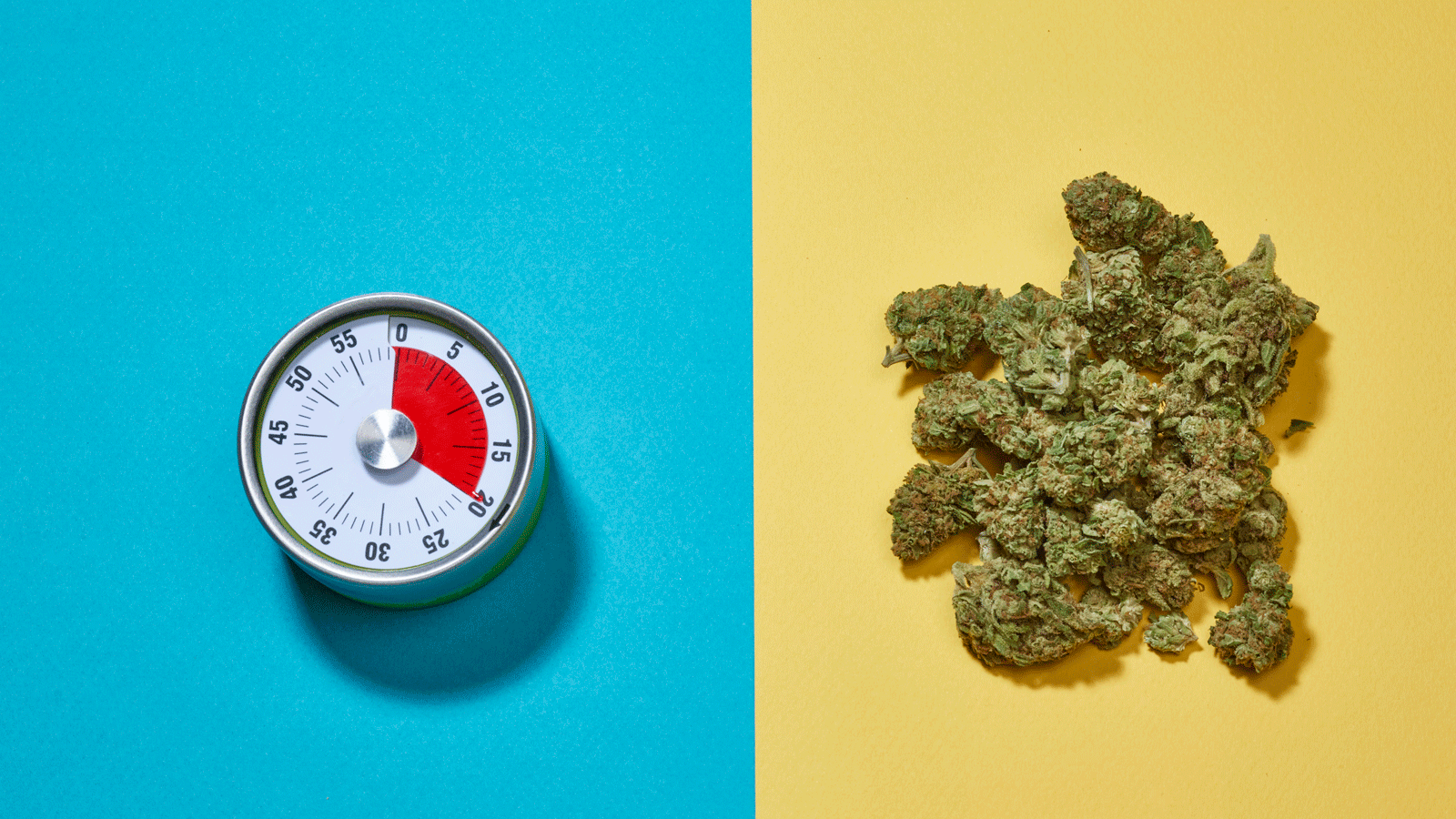
This article was originally published on Weedmaps and appears here with permission.
When we smoke or ingest cannabis, those unique plant compounds interact with our bodies. This interaction is the sole reason humans have turned to cannabis over the centuries for religious purposes, relaxation, pain relief, and recreation. This interaction also explains why cannabinoids and their byproducts remain detectable in the body and in many cases remain well after the buzz wears off.
In order to address the question, “How long does marijuana stay in your system?” we must first focus our attention on THC, or delta-9-tetrahydrocannabinol, the intoxicating cannabinoid known for creating euphoric, stoned effects. Other compounds stick around, too. But because THC remains federally illegal in the US, cannabis drug tests often exclusively screen for THC and THC metabolites, or byproducts that are produced when THC is broken down in the body.

After smoking weed, cannabinoids and their byproducts remain detectable in the body, and in many cases remain well after the buzz wears off.
Photo by: Gina Coleman/Weedmaps
How does cannabis travel through the body?
To fully understand how long weed could stay in your system, it's important to establish how THC travels through and interacts with the human body.
When cannabis is smoked or vaporized, THC enters the bloodstream through the lungs. From there, it is carried in the bloodstream directly to the heart and pumped throughout the body where it binds to the CB1 receptors located in the brain, certain organs, and central nervous system, as well as the CB2 receptors in the spleen and immune system. These receptors are part of the endocannabinoid system.
As blood circulates throughout the body, THC is continuously passed through the liver and broken down into metabolites. To detect the presence of cannabis in the body, most drug screening methods look for one metabolite called 11-nor-9-carboxy-THC, or THC-COOH.
This inactive metabolite of THC, which is stored in body fat and gradually eliminated through urine and feces, remains in the body for far longer than active THC. That's why so many marijuana detox drinks and kits claim to eliminate or mask the presence of THC metabolites.
The process is slightly different when cannabis is consumed in the form of an edible or capsule. When taken orally, THC enters the bloodstream through the walls of the stomach and intestines, traveling directly to the liver where a large amount is eliminated or metabolized. The remaining THC and THC metabolites are then circulated by the heart and sent to the brain.

One study claims that THC is detectable in blood for about five hours, but the THC metabolite THC-COOH has a detection time of up to 25 days.
Photo by: Gina Coleman/Weedmaps
Key factors that influence how long weed stays in your system
There are a variety of factors that might affect the amount of time that THC will stay in your system.
Dosage
The larger the amount of THC consumed, the longer it will take the body to break down and work through it and its corresponding metabolites.
Frequency of marijuana use
The overall duration and frequency of use have a substantial influence on the length of time that weed will stay in your system. Most research on cannabinoid detection demonstrates that THC stays in the system of chronic users far longer than one-time or even occasional users. Long-term, high-frequency cannabis use is also a notable risk factor in developing cannabis withdrawal symptoms.
Genetics
Genetics also affect the length of time that THC remains in the system. For instance, people inherit different variants of the cytochrome P450 superfamily of enzymes, which modify THC levels in the body, resulting in its elimination through the urine.
Fat
The amount of fat in the body is also a significant factor. The metabolite THC-COOH is fat-soluble and binds to fat molecules, where it can be stored for a lengthy period of time. In the same vein, exercise can also impact the levels of detectable THC metabolites. When fat is burned, dormant THC from fat can be released into the blood and excreted from the body in urine or feces.
Metabolism
A body with higher metabolic functions can break down cannabinoids at a faster rate, shortening the length of time that THC and its metabolites will remain detectable in the body.

A body with higher metabolic functions can break down cannabinoids at a faster rate.
Photo by: Gina Coleman/Weedmaps
How long does weed stay in your system?
There's no universal standard for how long weed stays in anyone's system because it depends on too many variables. THC and its metabolites can be detected in blood, urine, saliva, and hair. But existing research allows us to gain a better understanding and make well-educated estimates for various systems.
How long does weed stay in your blood?
Upon inhalation, active THC can be found in the bloodstream within a matter of seconds and can be detected in plasma for several hours, depending on the frequency of use and dosage. According to a 2004 review published in Therapeutic Drug Monitoring, the plasma concentration of THC peaks just three to eight minutes after inhalation and then decreases quickly with a half-life of about 30 minutes. The study claims that THC is detectable in blood for about five hours, but the THC metabolite THC-COOH has a detection time of up to 25 days.
In a 2009 study published in the journal Addiction, researchers monitored cannabinoid concentrations in the blood of 25 frequent cannabis users. During seven days of abstinence from cannabis use, nine subjects, or 36%, had no measurable THC in their system, while the other 16 still had at least one positive THC test over the same timeframe. After the weeklong period ended, six of the subjects still had detectable THC concentrations and all subjects had measurable levels of the metabolite THC-COOH.
So, while the active form of THC doesn't remain in your bloodstream for an extended period of time, THC metabolites can still be found in the body several weeks after use.
How long does weed stay in your urine?
Recognized as the preferred method for cannabis drug testing, urine screenings are often used as a benchmark to detect for cannabis use. Most urine tests utilize a specific sensitivity for the cutoff concentration of THC-COOH. The most common cutoff concentration point is 50 nanograms per milliliter (ng/mL), as suggested by the Substance Abuse and Mental Health Services Administration (SAMHSA).
A 2005 review published by the National Drug Court Institute states that THC detection times rarely exceeded 30 days. The study aims to provide “practical cannabinoid detection guidance,” despite the many factors that influence how long weed stays in the system.
Using the recommended cutoff concentration point of 50 ng/mL, the study suggests that a chronic cannabis user is unlikely to have detectable THC metabolites in their urine longer than 10 days after the most recent smoking session. At the lower, more sensitive 20 ng/mL cutoff concentration point, however, the metabolites in chronic cannabis users could be detected for up to 21 days after consumption, and possibly longer in some rare instances. For one-time users, however, the same study found that even with the more stringent 20 ng/mL cutoff concentration point, it would be unlikely for a drug screening to detect THC metabolites in urine after seven days.
According to a May 2017 review published in Mayo Clinic Proceedings, weed can be detected in urine for up to three days in occasional users, five to seven days in moderate users, 10 to 15 days in daily users, and more than 30 days for chronic users who consume multiple times a day.
How long does weed stay in your saliva?
THC and its metabolites can also be detected in the saliva of occasional and chronic users. A 2014 study published in Drug Testing and Analysis looked at cannabinoids in oral fluid and found that THC metabolites were detectable in the saliva of occasional users for one to three days and chronic users for up to 29 days.
How long does weed stay in your hair?
There is mounting evidence that hair follicle drug testing methods are not able to accurately detect marijuana, as research published in Scientific Reports suggests that the presence of THC and THC metabolites can be transferred to the hair follicles of non-users through contact with hands, sweat, or exhaled smoke.
For example, if someone smokes a joint and exhales near someone who doesn't consume cannabis, THC can be transferred to the non-smoker's head or body hair. The same Scientific Reports study found that, after giving participants 50 milligrams of THCA every day for one month, no THC was found in the hair specimen samples, but THC-COOH was still detected. As for the detection period, the hair follicle drug test timeline is much broader than with urine and blood tests, sometimes detecting the presence of THC up to 90 days after use.
On the other hand, a 2017 study published in Drug and Alcohol Review analyzed hair samples collected from 136 subjects and found detectable levels of THC in 77% of chronic users, 39% of light users, and in zero non-users, showing that the chance of having THC found in hair samples grows significantly with increased frequency of use. While the authors of the study stated that hair analysis is a viable method for detecting cannabis consumption, they also acknowledged that it's unreliable for detecting light cannabis use.







